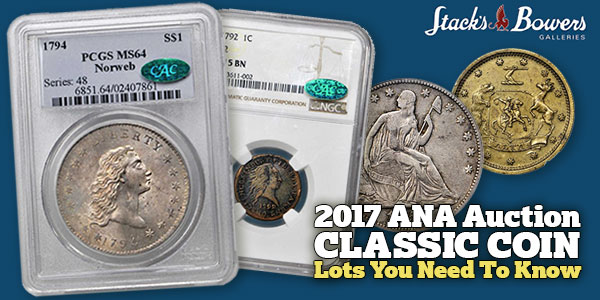
By CoinWeek …..
The American Numismatic Association’s (ANA) World’s Fair of Money remains one of the largest coin conventions in the calendar year. Stack’s Bowers, an Official Auctioneer of the ANA World’s Fair of Money, will conduct a seven-session sale over the course of eight days, with sale highlights featured in the Session Four “Rarities Night” on Thursday, August 3 (starting at 6:30pm MT). It will take place in Room 303 at the Colorado Convention Center and will also be simulcast online.
CoinWeek’s editors have studied the catalog and prepared a two-part Lots You Need to Know Auction Preview.
Part 1 discussed rare modern coins on offer during Rarities Night, while Part 2 (this installment) will focus on five key classic lots from the sale, including the Lord St. Oswald 1794 dollar, the finest-known 1853-O No Arrows half dollar, and more…
* * *
Lots 2004: 1792 Cent. Without Silver Center. Judd-2. Pollock-2. Rarity 7. Copper. Reeded Edge. F-15 BN (NGC)
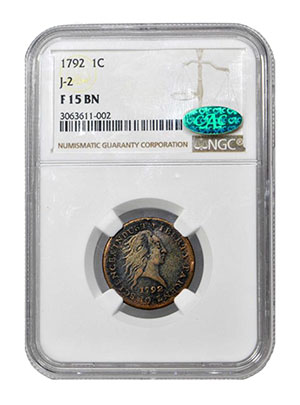 Numismatic research places this pattern coin at the humblest beginnings of U.S. federal coinage. It was produced under the authority of the Mint Act of 1792 and likely struck in December of that year as a proof-of-concept for lawmakers. This coin type and others were alluded to in Thomas Jefferson’s correspondence to George Washington, dated December 18, 1792 (although Andrew Pollock III writes in his authoritative United States Patterns and Related Issues that only the silver plug version was struck by this time[1]). It was clear to Jefferson at the time that the size and composition of this pattern was not in alignment with the copper coin that Congress had authorized.
Numismatic research places this pattern coin at the humblest beginnings of U.S. federal coinage. It was produced under the authority of the Mint Act of 1792 and likely struck in December of that year as a proof-of-concept for lawmakers. This coin type and others were alluded to in Thomas Jefferson’s correspondence to George Washington, dated December 18, 1792 (although Andrew Pollock III writes in his authoritative United States Patterns and Related Issues that only the silver plug version was struck by this time[1]). It was clear to Jefferson at the time that the size and composition of this pattern was not in alignment with the copper coin that Congress had authorized.
As a pattern (and one struck in an alternate composition), the piece was not produced in significant numbers and today counts fewer than 10 pieces among its known survivors. Which makes it not only a significant piece of early American numismatic history but also a great rarity that can be acquired only by those seeking to build one of the finest numismatic cabinets in the American series.
The design features ideas both kept and abandoned.
Wrapping around the frightful bust of Liberty is the inscription LIBERTY PARENT OF SCIENCE & INDUSTRY. Beneath the bust truncation is the date 1792. This inscription would be abandoned by the time regular copper coinage commenced in 1793. But the basic motif on the coin’s reverse – ONE CENT inside a laurel wreath, the fraction 1/100 below the ribbon in the exergue, UNITED STATES OF AMERICA wrapping around just inside a circle of denticles – would form the basis of copper cents and half cents (excepting for the Chain Cent) from 1793 until the end of the Draped Bust period of 1807/1808.
Due to the similarity in the design of the Liberty head to that of the adopted Chain Cent type of 1793, numismatists speculate that the design was the work of chief coiner Henry Voigt. Voigt was the de facto “Chief Engraver” at the Mint until a permanent one could be installed[2].
PCGS accounts for three coins in their population report and places the Lorin G. Parmelee coin at the top of their census, with an estimated grade of AU53. The finest example PCGS has certified (VF35) was the Wolcott specimen, which likely stayed with the family for more than 200 years before it surfaced in 2004. That example sold in 2016 for $352,500.
The current piece is the same coin (the Lauder-Simpson specimen) that Heritage Auctions sold in 2012 for $299,000.
The coin has been reholdered but maintains the same F15BN grade, certificate number, and CAC green sticker as before. It is now mounted in a current generation NGC Edgeview holder, allowing for better appreciation of the coin’s “three” sides. For a 200-year-old rarity, there isn’t much to criticize about the look of the coin. It is accurately graded according to NGC and EAC standards. Nitpickers may note a slight rim ding at three o’clock and the rose-colored highlights around the edges of the coin, which point to a long-ago cleaning (possibly a necessary one). But these are trifling objections for a Rarity 7 coin.
- Current Bid: $6,500 USD
Lots 2013: 1796 Draped Bust Cent. S-92. Rarity 3+. Reverse of 1795. MS-66RB (PCGS)
The May 4, 1999 sale of the “Mr. 1796” John Whitney Walter Collection has always been one of my favorite numismatic auctions of the late 20th century. Not only did Stack’s produce one of the most interesting and idiosyncratic auction catalogs in recent memory, the collection itself, as sophisticated and high-quality a study of a single date ever attempted, wows at every turn.
So great was that collection that the present coin, Walter’s 1796 Sheldon-92, the finest known of the variety, would hardly have been considered a headliner. Such is life for even one of the most attractive Bust cents when paired up against the likes of Jimmy Hayes’ Specimen Strike JR.1a dime, the C.A. Allenburger 1796 15 Stars (O.101A) and Lelan Rogers (O.102a) half dollars, and the Ketterman 1796/5 gold $5 and 1796 gold $10. Like I said, it was an incredible collection.
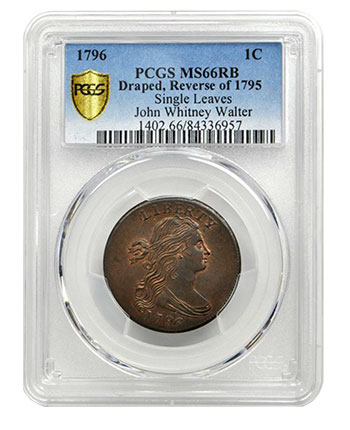 The catalog, written with the aid of John Walter himself, describes the present coin this way:
The catalog, written with the aid of John Walter himself, describes the present coin this way:
“An amazing red and brown Cent. The obverse shows 40% of the original mint red color still remaining while the reverse has nearly 60% full red color…. Super sharp strike everywhere, with the veins in the reverse leaves and strands in Liberty’s hair bold and clear.”[3]
The coin brought $41,400.
The Sheldon-92 variety features an exclusive die marriage consisting of Obverse die 7 and Reverse H. On the obverse, the E and the R in LIBERTY touch at the bottom. The 9 and the 6 digits in the date are struck very close to one another, with the 6 leaning to the right. Miss Liberty is often found with a double struck profile, as is the case with this example.
On the reverse, AME is joined at the bottom and there is considerable distance between ONE and CENT. The present example is heavily clashed on the reverse, but does not exhibit the rim break at five o’clock that occurs on this die variety in later die states.
The lack of obverse dentiles is typical for the variety.
With an estimated surviving population (in all grades) of 1,500 to 1,750 pieces, all 1796 cents are scarce. Stack’s Bowers points out the fact that the Pogue 1796, Reverse of 1794 (S-110) variety brought $329,000 against an estimate of $120,000 to $150,000. That coin was graded MS66+BN by PCGS, but its important to note that serious copper collectors march to the beat of their own drum and take their own EAC grading standards more seriously[4].
What is the finest-known S-92 worth to the hobby’s most discerning copper collectors? We’ll see on the night of August 3.
- Current Bid: $8,000 USD
Lots 2063: 1871 Liberty Seated Dime. MS-68* (NGC). CAC.
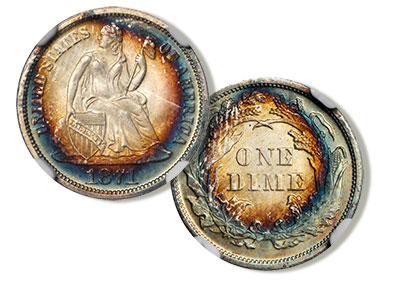 Vividly toned, original, and the finest-known example certified by either NGC or PCGS by nearly two grades, this CAC-approved example graded MS68* by NGC is unquestionably the finest-known example of the issue. Struck using the F-102a die pairing that was used to strike Proofs, the coin exhibits satiny surfaces and full detail. A die crack runs between the two ends of the ribbon on the reverse.
Vividly toned, original, and the finest-known example certified by either NGC or PCGS by nearly two grades, this CAC-approved example graded MS68* by NGC is unquestionably the finest-known example of the issue. Struck using the F-102a die pairing that was used to strike Proofs, the coin exhibits satiny surfaces and full detail. A die crack runs between the two ends of the ribbon on the reverse.
Those interested in building a high-end U.S. type set should consider this coin as combined NGC and PCGS account for only 95 Liberty Seated dimes at the MS68 level with just three higher, while CAC has approved only 12 at MS68. A beautifully toned PCGS MS66 (CAC) brought $7,055 at a 2014 Heritage Auctions sale. Expect this example to sell for considerably more.
To dig further into the appeal of this coin, we asked Seated Liberty dime expert and coin dealer Gerry Fortin to share his thoughts in this CoinWeek Exclusive Expert Insight.
- Current Bid: $55
Lot 2099: 1853-O Liberty Seated Half Dollar. No Arrows. WB-NC-1. Rarity-7+. VF-35 (PCGS).
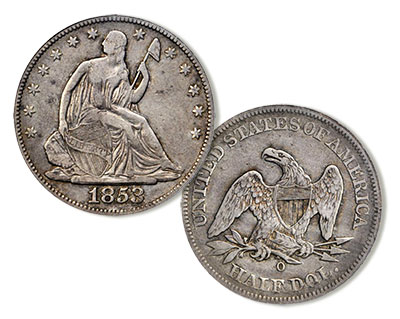
Up until a few years ago, there were only three examples of the 1853-O No Arrows half dollar known.
A fourth example came to light when the family of a Northwest collector brought the coin, later graded VG8 by PCGS, to Stack’s Bowers’ attention.
For the mysterious and elusive 1853-O No Arrows type half dollar, it was the first discovery of a “new” coin since a Chicago trolley conductor reportedly found one in 1909.
The other known examples, a PCGS G-6 once belonging to “Colonel” E.H.R. Green and the present coin, have been traced back to 19th-century collectors Colin E. King and J. Colvin Randall. King’s collection was sold by the Chapman Brothers in April 1892, while Randall, a student of varieties, worked with dealer John Haseltine to write the Haseltine Type Table, a significant reference for the period.
Longtime Gobrecht Journal editor John McCloskey, on the occasion of having viewed Randall’s personal copy of Haseltine’s November 82-30, 1881 Bangs & Company auction catalog, discovered Randall’s own notes, inscribed on the inner cover, that give evidence that Randall was in possession of the coin in 1884. Over the years, the coin has passed through a number of significant collections, including the Garrett and Queller Collections.
Another who took possession of the coin and is the consignor in this sale, is dealer Rich Uhrich. He acquired the piece in January and had it on display at his booth at the FUN Show in Fort Lauderdale, where he showed it to us. Upon finding out that this coin would be in Stack’s Bowers Rarities Night auction, we reached out to Rich to discuss what it was like to own one of the great rarities in American numismatics.
- Current Bid: $15,000
Lot 2113: 1794 Flowing Hair Silver Dollar. BB-1, B-1. Rarity-4. MS64 (PCGS). CAC.
1,758 one dollar coins were struck by the United States Mint in 1794. All known coins were struck from the same die pair, and the issue has been widely studied and commented on by collectors and researchers over the years. This is the first dollar coin and as such is the basis for the American monetary system. Our earliest federal copper coins, the cent and the half cent, even though they were issued a year before the U.S. Mint was able to strike the dollar coin, were inscribed with fractions of this dollar coin 1/200 & 1/100. The half dime, the dime, the quarter and the half dollar were sized according to denominated value in proportion to this one dollar coin.
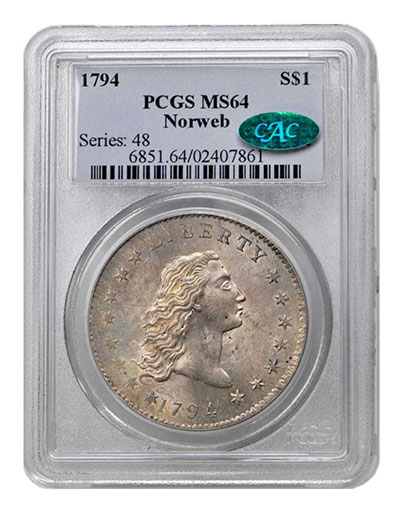 The lion’s share of 1794 dollars have been lost to time. The combined certified population for this issue is 132 pieces, with an additional 10 “details grade” coins denoted by NGC. The 132 number must be taken with a grain of salt as there is no way to account for resubmissions or crossovers. In Mint State, it appears that the NGC report is unreliable at the top end of the Mint State spectrum as PCGS’ total is an exact match and the Condition Census reported by Stack’s Bowers in its lot description of this coin shows that the Virgil Brand coin has crossed down from MS64 (NGC) to MS63+ (PCGS) since it was offered in August 2010. This piece ranks as number four on that tally.
The lion’s share of 1794 dollars have been lost to time. The combined certified population for this issue is 132 pieces, with an additional 10 “details grade” coins denoted by NGC. The 132 number must be taken with a grain of salt as there is no way to account for resubmissions or crossovers. In Mint State, it appears that the NGC report is unreliable at the top end of the Mint State spectrum as PCGS’ total is an exact match and the Condition Census reported by Stack’s Bowers in its lot description of this coin shows that the Virgil Brand coin has crossed down from MS64 (NGC) to MS63+ (PCGS) since it was offered in August 2010. This piece ranks as number four on that tally.
This example is one of two meticulously preserved 1794 dollars from the Lord St. Oswald Collection. The St. Oswald coins came to light when Christie’s offered them in their famous 1964 sale. The story of their provenance traces back to an English farmer named William Strickland, who toured the United States from September 20, 1794 to July 29, 1795. During his travels, he met with former Secretary of State and future President Thomas Jefferson and then-President George Washington. The coins were kept, along with 82 other U.S. and pre-federal coins that Strickland accumulated during his stay.
The finer of the two 1794 dollars (PCGS MS66) was auctioned on September 15, 2015 in the second session of the Pogue Sales, where it brought $4,993,750. The coin has since upgraded to MS66+ (the silver-plugged 1794 “Cardinal” dollar that sold for $10,016,875 in January 2013 is considered a Specimen Strike). A bid of $1.25 to $1.75 million dollars would not be out of the question for this spectacular rarity.
- Current Bid: $260,000
Lot 2193: 1909 Indian Half Eagle. Proof-67* (NGC)
 Underrated in nearly every respect, gold Proofs of the early 20th century represent the pinnacle of American coin design and boast an array of finishes, that while not popular upon their initial release, have developed a following over the years as numismatists study and collect them.
Underrated in nearly every respect, gold Proofs of the early 20th century represent the pinnacle of American coin design and boast an array of finishes, that while not popular upon their initial release, have developed a following over the years as numismatists study and collect them.
Our own experience mirrors what many feel. We always pause on the bourse when we find an especially nice Satin or Roman Finish Proof of this time period, especially when one has the charm of the presently offered 1909 half eagle in NGC PF67*.
Featuring a detailed portrait of an American Indian chief in a headdress depicted in Egyptian Relief, our last circulating gold $2.50 and $5.00 coins were struck from 1908-1929, with a hiatus of 10 years for the $2.50 (1916-1924) and 12 years for the $5.00 (1917-1928). Proofs were struck at the Philadelphia Mint and issued only between 1908 and 1915.
The NGC census shows a population of nine pieces in PF67, three with the Star designation, and eight in PF68. The PCGS population report has one example in PR67 and one in PR67+ -the current CoinFacts plate coin – which is also the only CAC-approved coin at this grade level. That coin brought $105,750 at a February 2016 Heritage Auctions sale. This example last brought $64,625 when it was offered at Heritage’s 2016 Central States Numismatic Society US Coins Signature Auction.
- Current Bid: $550
Lot 2250: 1849 Massachusetts & California Co. $10 Die Trial. K-6A. Rarity-8. Brass. Reeded Edge. MS61 (NGC)

Donald Kagin in his book Private Gold Coins and Patterns of the United States describes the Massachusetts & California Company as a company “…created for the expressed purpose of capitalizing on the shortage of coins in California.”[5] This was not a company of grifters and adventurers, but one made up of jewelers and Ivy League-educated professionals. Such was the mania of the gold rush in California, that it beckoned all manner of people to the golden shores of the western territory. According to Kagin’s research, the company’s minting operation never made it to California. It’s coinage, therefore, was likely struck in Massachusetts using locally sourced bullion.
The $10 gold piece, a newly discovered trial strike in copper being on offer at Stack’s Bowers Rarities Night auction, has never turned up in gold. Its design is a collage of all manner of western motifs: the cowboy, the bear, the dear, and Poseidon’s arm with a trident(?) in hand. In scroll work, the letters ALTA appear. Could that reference the Alice Tarlton, the ship on which the company was set to set sail in May of 1849?
The other known example of this piece was held for more than 30 years in the John J. Ford Collection. That piece was slightly larger and heavier than the present example; also it was well worn and described as VF-30 in Stack’s Bowers catalog[6]. This example is gorgeous with every detail fully realized. NGC assigns the trial strike the grade MS61. In 2016, a unique $5 Massachusetts & Company copper die trial in NGC MS63BN brought $10,575 at auction.
It would be safe to assume that this piece will bring equal or greater attention.
- Current Bid: $75
* * *
Stack’s Bowers’ The High Rise and Magnolia Collections and Other Important Properties: An Official Auction of the American Numismatic Association’s World’s Fair of Money
Session Listing:
Session 1: U.S. Coins Part I – Lots 1-575
AUGUST 1, 2017 • 5 PM MT • COLORADO CONVENTION CENTER • ROOM 303
Session 1 – Numismatic Americana, Colonial Coins and Related, Half Cents through Quarters. The live auction session begins at 5:00PM MT on Tuesday, August 1.
Session 2: U.S. Currency – Lots 10001-10551
AUGUST 2, 2017 • 6:30 PM MT • COLORADO CONVENTION CENTER • ROOM 303
Session 2 – The live auction session begins at 6:30PM MT on Wednesday, August 2.
Session 3: U.S. Coins Par II – Lots 1001-1536
AUGUST 3, 2017 • 11:00 AM MT • COLORADO CONVENTION CENTER • ROOM 303
Session 3 – Half Dollars through Misc. U.S., Private and Territorial Gold, Hawaiian Coins and Related. The live auction session begins at 11:00AM MT on Thursday, August 3.
Session 4: Rarities Night – Lots 2001-2256
AUGUST 3, 2017 • 6:30 AM MT • COLORADO CONVENTION CENTER • ROOM 303
Session 4 – The live auction session begins at 6:30PM MT on Thursday, August 3.
Session 5: Internet Only – U.S. Coins Part I – Lots 3001-3754
AUGUST 7, 2017 • 9:00 AM MT
Session 5 – The live auction session begins at 9:00AM MT on Monday, August 7.
Session 6: Internet Only – U.S. Coins Part II – Lots 4001-4633
AUGUST 8, 2017 • 9:00 AM MT
Session 6 – The live auction session begins at 9:00AM MT on Tuesday, August 8.
Session 6: Internet Only – U.S. Currency – Lots 11001-11286
AUGUST 8, 2017 • 9:00 AM MT
Session 7 – The live auction session begins at 9:00AM MT on Tuesday, August 8.
* * *
Notes
[1] Pollock, III, Andrew W. United States Patterns and Related Issues. Wolfeboro, New Hampshire: Bowers & Merena Galleries. 1994. 11.
[2] Orosz, Joel J. and Leonard Augsburger. The Secret History of the First U.S. Mint: How Frank H. Stewart Destroyed and Then Saved a National Treasure. Atlanta, Georgia: Whitman Publishing, LLC. 2011. 35.
[3] Public Auction Sale “Mr. 1796” The John Whitney Walter Collection: The Coins of 1796. May 4, 1999. New York: Stack’s. 27.
[4] Morgan, Charles and William Eckberg. CoinWeek IQ: EAC Grading Demystified: MS60 to MS70. Richmond, Virginia: CoinWeek. Video. 2016.
[5] Kagin, Ph.D., Donald H. Private Gold Coins and Patterns of the United States. New York: Arco. 1981. 73.
[6] John J. Ford, Jr. Collection: Coins, Medals and Currency, Part XXIV. September 19-20, 2013. New York: Stack’s Bowers. 43.




